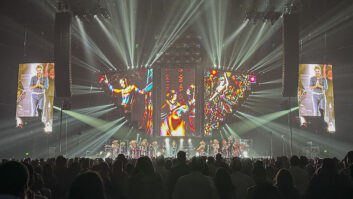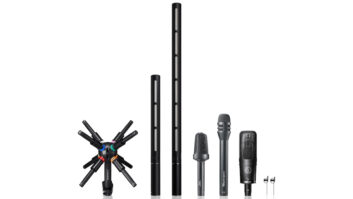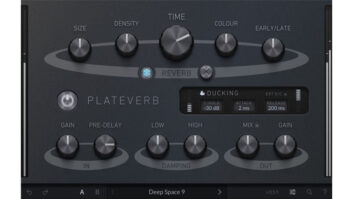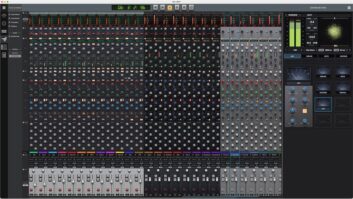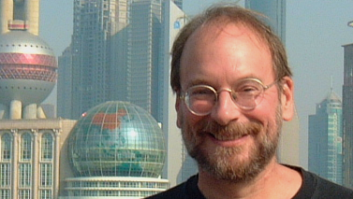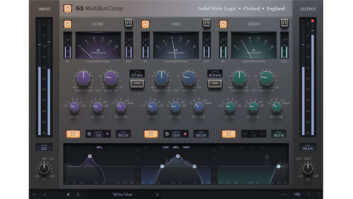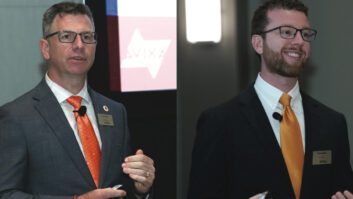photo: PHIL BRAY
On a splendid May morning in Building 180 on Treasure Island, in the middle of the San Francisco Bay, the principal cast members of director Chris Columbus’ film version of the hit stage musical Rent (Revolution Studios, Sony Pictures) are slowly assembling for the day’s shoot. What was once a hangar on a former military base has been magically transformed into a series of elaborate film sets. The story takes place in New York, and at the heart of the elevated set is a large, funky loft that has been rendered in such amazing detail it looks like it was dropped in by helicopter from Manhattan.
Through the loft’s “windows,” a radically scaled-down version of a New York City street is in the foreground; behind that is a huge photo of a section of New York skyline — a Translite film — that must stretch 100 feet or more around the soundstage. When it is lit from behind, it looks astonishingly real. Outside, the loft set is the usual clutter one expects to find during a movie production: batteries of lights, props of every kind (in this case, it’s all thrift store clothing and furniture, in keeping with the story’s financially humble characters), a set of tracks for dolly shots behind the loft and, in an adjacent area currently being used for lunch service, a replica subway car that will figure into the story later. There was also some exterior filming on location in New York, but Columbus lives in the San Francisco Bay Area and likes to shoot locally when he can, so all of the interior locations and sets, as well as any exteriors production that can cheat to look like Greenwich Village, are shot here.
The on-set sound world is located on a platform adjacent to the loft. It’s here that we find production sound mixer Nelson Stoll, music supervisor Matthew Sullivan, music playback Pro Tools operator Erich Stratmann and — what’s this? — some of the attractive young cast members waiting to start filming the next scene. For some reason, when Stoll invited me to the set to check out the action, I didn’t think that stars Rosario Dawson and Taye Diggs would be hanging out with the sound crew before takes. And you didn’t think production sound was glamorous! [Note: Dawson, Diggs, Anthony Rapp and a few others are from the original Broadway cast.]
“The Rent soundtrack comprises mostly pre-recorded songs,” Stoll explains, “but there are also a number of short dialog scenes and live transitions in the film that bridge and supplement the songs. Chris Columbus also wanted to record some elements live and have them seamlessly integrate into the pre-records. One was a live stage performance scene, ‘Over the Moon,’ by Maureen [played by Idina Menzel], a protest/rally in support of housing for the homeless and local artists. Because of the improvisational nature of the performance and the interaction with the audience, protesters and police, the dynamic power of the scene would be lost if it was all lip-synch to playback. Using a DPA headset mic allowed us to record all the dynamic detail of her performance, while keeping the background noise very low. The consistent high quality was just what we needed to transparently mix it into all the other pre-recorded music elements.”
Sound mixer Nelson Stoll with his custom, soundproof music playback cart
Stoll has been involved with film sound since the ’70s, getting his start working on documentaries and later moving on to big-budget features, including Dune; Total Recall; Basic Instinct; The Cable Guy; Francis Ford Coppola’s The Rainmaker; the Chris Columbus films Mrs. Doubtfire, Nine Months and Bicentennial Man; and many more. He takes the art and craft of production sound very seriously and has tried to stay on the technological tip of the profession by continually updating his rig and recording methods.
“For Rent, I wanted to make sure we had a quality 24-bit multitrack for our main production recorder to give the film sound the creative flexibility we would need,” he says. “After my experience using a [Zaxcom] Deva to record multitrack stereo effects on the last two Matrix films, I wanted to deliver the multitrack audio on FireWire hard drives. The transfer rates are just too slow with DVD-RAM disks to meet the editorial time demands for dailies, especially recording high-track — count 24-bit files.
“To maintain 24-bit quality through the final mix meant very early coordination and planning with picture editing, telecine transfer, dailies projection and especially Skywalker Sound post, even though it would be many months until sound editing would begin,” he continues. “I found out the hard way that the production sound quality in the final film usually suffers without this oversight. So I was pushing the process and wanted to make sure it all worked. An added bonus is that this workflow planning is also necessary to control costs.”
On a musical film such as this, it was critical to balance the needs of production recording with providing a workable playback environment for the actors. According to Stoll, “I designed a soundproofed music playback cart, based on a Pro Tools DAW running on a water-cooled 2.5GHz Mac. The Digi 002 Rack interface fed a Mackie console to distribute wired and wireless music and music timecode. Under the direction of our music supervisor, Matt Sullivan, our on-set music editor, Erich Stratmann, provided the custom sync playback music mixes needed. These were edited from the multitrack music stems from the music studio.
“We worked hard to use quality medium-high — level speaker playback whenever possible, as the actors seem to more effectively immerse themselves in the music, providing performances that appear much more real. Since lip-synch is so critical in making a musical film believable, I wanted to use speakers that were very coherent, natural-sounding and clear, while still having the power and directional punch to reach in the wide shots where the speakers could not be close. I had used Meyer UPAs in the past, but was concerned about their weight in our fast-moving film environment. The smaller Meyer UPJ turned out to be just the ticket and had plenty of power in all but a few situations where we used an array of two of them in a custom, adjustable mount on a high stand.
“We were also equipped to feed the music to wireless earpieces when speakers could not be used and to feed a 40Hz ‘thumper’ track to a subwoofer when neither speaker playback nor earpieces would work,” says Stoll.
One challenging situation during the limited filming in New York arose because of the city’s strict limitations on playback volume. For shots of Rapp’s character singing while riding a bicycle, “The wireless earpieces did not fit well in Anthony’s ear and we decided a portable speaker was a better solution,” Stoll says. “So we put a small radio-fed speaker in his backpack for sync music playback.” Stoll notes that the production mixer for the New York scenes was Danny Michaels, “who is experienced with music film playback.
“The big Greenwich Village exterior crowd scenes outside the loft were shot on the back lot at Warner’s in L.A., because both New York City and the Bay Area had strict noise limits after 10 p.m.,” Stoll continues. “Even on the lot in L.A. I had to make and document anticipated noise level measurements in the adjacent neighborhood due to concerns that we would be shut down. Luckily, all went well and we got great performances.”
For capturing the actual production tracks, Stoll chose an HHB PortaDrive 8-track, 24-bit digital hard disk recorder. Why? “The ability to record eight tracks, having an accurate timecode clock, complete word clock I/O to allow synchronization with outboard digital equipment and additional recorders, and the ability to deliver BWF files on FAT-32 FireWire drives were some of the reasons,” he answers. “We had some initial quality control problems with our first recorder, but once we got a new machine, we had no problem with any of the recordings and it was rock-solid for the show. Whatever mics were used to record the scene — including all boom mics, radio mics and special mic plants — would be recorded to discrete iso tracks. This allowed post sound to create any desired custom mixes to match different camera perspectives or any other mix needs.”
Stoll notes that although he likes the A/D converters in the PortaDrive, “I wanted to use multiple Waves L2 hardware Ultramaximizers for conversion, dither, noise shaping and dynamics control. The L2 was the first A-to-D converter/processor that allowed us to record digital production audio that exceeded the quality of our best analog tracking.
“The L2 has two unique features that I feel should be included in every digital production recorder,” Stoll continues. “One is a transparent, configurable digital limiter — a look-ahead process with about 25 dB of limiting. The other is the related ability to set the maximum recorded dBfs [digital full scale] level. When recording 16-bit audio, we usually set this to -1 dBfs and have it set to -3 dBfs for 24-bit. Levels above this can add distortion for a variety of reasons. This type of device is especially useful when you have to deliver 16-bit masters and you want to retain the best quality through the film release print. Making judicious use of the limiter and mild noise shaping on the L2 makes 16-bit recordings close to good 20-bit masters — and overload-proof. Just make sure your analog front end is up to it!
“The multiple L2s were fed by my Neve analog console via custom direct amps, designed by Stephen Balliet of Reflection Audio. Stephen, many times, is the recordist, freeing me up to do the sound design, mic mounting and placement, and overall mixing.” Stoll’s other assistant on the film was Brian Copenhagen, who handled most of the equipment management and second boom work.
Stoll’s goal was to provide high-quality production audio that meshed perfectly with the copious pre-recorded elements. The result: a musical that feels natural, not staged. “Being able to contribute to a powerful, sound-driven film like Rent gives me great satisfaction,” he says. “It is very hard for both the filmmakers and the film viewers not to immerse themselves in a wonderful production like this. I dare you to try not to tap your feet to the music when you see it!”
